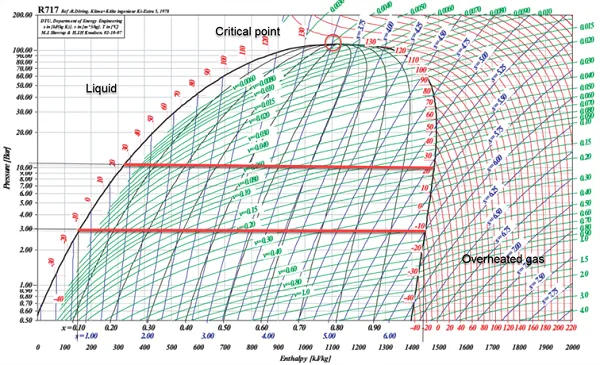
Choosing natural refrigerants | Ammonia (NH3)
Choosing natural refrigerants | Ammonia
R717 Ammonia
Natural refrigerants are a hot topic. With more and more onshore utility-based installations switching to natural gas, what’s the situation in the maritime industry? Selecting the right refrigerant is no easy task as each type has its own pros and cons. In this series of blogs we explore the most common natural refrigerants to help you decide which best suits your specific application.
Ammonia is one of the oldest refrigerants there is, used from the days of the first cooling machines. A common gas in nature, ammonia (NH3) consists of one nitrogen and three hydrogen atoms.
To give you a comprehensive overview we are comparing every refrigerant on the following fixed set of properties:
| Thermodynamic properties | Safety | Sustainability |
| Temperatures | Flammability | GWP |
| Pressures | Toxicity | Ozone depletion |
| Latent heat capacity | Pressure | Energy efficiency |
| Corrosive |
All starting points are the same for every refrigerant, including the temperatures below:
Evaporation temperature: -10°C
Condensation temperature: 25°C
Overheating 20K
Subcooling 5K

Figure 1: H-log/P diagram R717 (NH3)
Thermodynamic properties
Ammonia has one of the best thermodynamic properties of all refrigerants. With a broad temperature spectrum, relatively low working pressures and a massive latent heat capacity, it is a great gas to use as a refrigerant.
- Evaporation and condensation temperature
R717 has a high temperature range and with a critical point above 132°C can easily be used with seawater condensers. The triple point lies at -78°C, making it suitable for both chilled water and provision cooling purposes. - Evaporation and condensation pressure
While having a higher pressure than R134a, the difference is slight. At an evaporating temperature of -10°C the absolute pressure is around 3 bar; at a condensation temperature of 25°C the absolute pressure is around 11 bar. - Latent heat capacity
Latent heat values are very high with ammonia which can absorb large amounts of thermal energy before being changed in phase. The enthalpy at the -10°C line will be around 1,250 kJ/kg.
Safety
Looking at the safety classification, R717’s specs are less favourable than other natural refrigerants. It is classified as B2L.
|
Safety group |
Lower toxicity |
Higher toxicity |
| High flammability |
A3 |
B3 |
| Flammable |
A2 |
B2 |
| Lower flammability |
A2L |
B2L |
| No flame propagation |
A1 |
B1 |
- Flammability
Low flammability so can ignite when exposed in certain concentrations. - Toxicity
Exposure to high concentrations causes immediate burning of the nose, throat and airways, which can result in respiratory distress or failure. Inhalation of lower concentrations may cause coughing and irritation of the nose and throat. Although the pungent smell of R717 fortunately provides early warning of its presence, exposure also causes loss of smell. Consciousness is reduced with prolonged exposure at low concentrations. - Pressure
R717 has no pressure issues. - Corrosion
Exposure to low concentrations can quickly lead to skin or eye irritation. Exposure to higher concentrations can lead to serious injuries and burns. Contact with liquid ammonia can lead to frostbite, although that is the case with all refrigerants.
The corrosiveness of ammonia makes it unsuitable for installations with copper pipes and the electric wiring inside the compressor must be separated from moving parts.
Sustainability
Although toxic to humans, R717 is a substance that occurs naturally on earth. With low GWP and ozone depletion values, leakages have hardly any effect on the environment. The high efficiency contributes to fewer CO2 emissions from generators.
- GWP & ozone depletion
As the global warming potential of ammonia is 0 it makes no contribution to the greenhouse effect. With the ozone depletion capacity equal to 0, emissions have no effect on the ozone layer. - Energy efficiency
At the given conditions the maximum energy efficient ratio will be 4.5. The combination with R717’s high latent heat capacity has an especially beneficial effect. Far less refrigerant and compressor power is required for a large cooling capacity. The high efficiency means less generator power is needed and the CO2 emissions caused by generator use are further reduced.
Conclusion
R717 is a wonderful refrigerant with excellent thermodynamic properties, a high efficiency and a low environmental impact. The downside is the high degree of toxicity, which means that many safety measures are required.
Please note that the values and calculation given in this article have been simplified in order to give you a general overview of the pros and cons of this refrigerant. More specific information is needed for a detailed calculation and we strongly recommend contacting one of our engineers if you are considering the use of natural refrigerants.
Want to learn more about natural refrigerants? You can download our extensive whitepaper here.